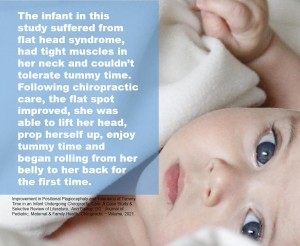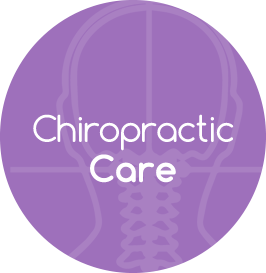In this case, the 4-month-old infant had plagiocephaly with the flattening more noticeable on right side back of
 her head. She would become fussy when placed on her belly and could not tolerate tummy time for long periods of time.
her head. She would become fussy when placed on her belly and could not tolerate tummy time for long periods of time.
The chiropractor evaluated her and found structural shifts in her skull, neck, mid back, and sacrum. Restricted motion was noted in her neck where she had tight muscles and altered posture. These structural shifts can lead to obstruction of the nerves and it is this obstruction, called vertebral subluxations, that chiropractors correct.
Following chiropractic adjustments, her range of motion improved in her neck and she was able to tolerate being on her belly for tummy time. She showed more muscle control and strength as she was able to prop herself up and lift her head. She also began rolling from her belly to her back. Her plagiocephaly improved as well.
The study’s author called for additional research to investigate the clinical implications of chiropractic in this population.
Reference: Improvement in Positional Plagiocephaly and Tolerance of Tummy Time in an Infant Undergoing Chiropractic Care: A Case Study & Selective Review of Literature. Ann Bishop, DC. Journal of Pediatric, Maternal & Family Health, Chiropractic ˜ Volume, 2021.
Deformational Plagiocephaly – FACTS
Deformational plagiocephaly is when a baby develops a lasting flat spot on one side of the head or the back of the head. There can be many causes including birth trauma. It can also happen when a baby sleeps in the same position most of the time or because of problems with the neck muscles. This condition is also called flat head syndrome.
When a baby’s head stays in one position for long periods of time, the skull flattens. Sometimes a baby is born with this flattening because of a tight space in the uterus. This might happen if there is more than one baby. Muscular torticollis can also cause deformational plagiocephaly. Muscular torticollis is a problem where one or more of the neck muscles is very tight. This tightness keeps the baby’s head in the same position.
Chiropractors work with the alignment and movement of the bones that make up the spine and because of the relationship between the spine, nerves, and muscles they can affect the head.
A number of sources suggest there is a link between plagiocephaly and the birth process. Possible proposed reasons for such a link include small maternal pelvis, multiple births, breech position, oligohydramnios, male sex of the fetus, gestational diabetes, nulliparity in the mother, high birth weight, large neonatal head size, vaginal delivery, prolonged length of post-delivery hospital stay and prolonged duration of stage 2 labor.
The scientific literature shows numerous studies reporting positive changes or resolution of plagiocephaly in infants while they were under regular chiropractic care using a variety of chiropractic techniques. Most reported assessment and correction specifically of structural spinal shifts called vertebral subluxations.
Structural spinal shifts, termed vertebral subluxations by chiropractors, result in structural and neurological obstruction to the spine and nerve system and chiropractors correct or reduce these obstructions through gentle and specific chiropractic adjustments.


